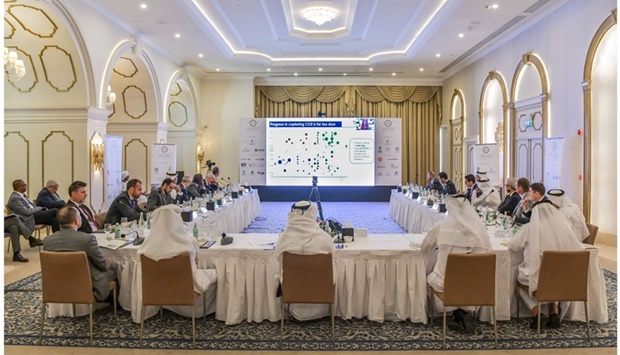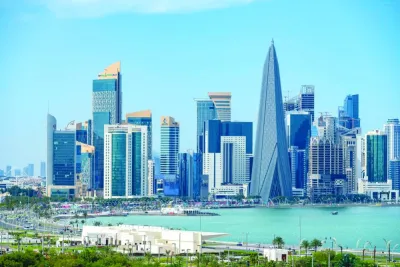Renowned experts and top decision makers came together in Doha to share their insights and perspectives on the current and future role of Carbon Capture Utilisation and Storage (CCUS) in the fight against climate change at the latest 'CEO Roundtable' hosted by the Al-Attiyah Foundation.
The roundtable, titled ‘Assessing the role of Carbon Capture Utilisation and Storage (CCUS),’ yesterday featured distinguished speakers; Braulio Pikman, technical director at ERM, Ian Kuwahara, director (Energy and Industrial Innovation) at VERRA, Martina Lyons, an associate programme officer at IRENA and Andrea Zambianco, Fertilizer & Syngas business manager at Saipem.
At the event, moderated by CGTN host Nawied Jabarkhyl, experts discussed the growing importance of CCUS in the fight to reduce manmade carbon dioxide emissions released into the atmosphere.
CCUS is a suite of technologies to capture CO2 from carbon-emitting processes and to store it safely for the long term in underground rock formations or convert it into useful products or stable minerals.
CCUS involves three steps aimed at reducing the release of anthropogenic CO2 emissions into the atmosphere. Carbon dioxide is captured from anthropogenic sources; it is transported to the injection site; and permanently stored in geological storage or utilised.
From this process, experts estimate that the best technology could capture up to 90% of the CO2 emissions produced from the use of fossil fuels in electricity generation and industrial processes.
Speakers agreed that CCUS has the potential to play a crucial role in tackling carbon emissions, including in hard to abate sectors such as manufacturing and industrial power, but noted further innovation is crucial for further adoption in key industries.
The Sleipner CCS installation off Norway went live in 1996 as part of a natural gas development, and since that time roughly one million tonnes of CO2 per annum has been gathered, compressed and re-injected into subsea geological formations.
In March, QatarEnergy outlined pioneering plans to scale up its CCUS and solar power generation capabilities as part of its drive to significantly reduce the carbon footprint at its facilities.
In an update of its sustainability strategy, QatarEnergy revealed it will develop “carbon capture and storage technology to capture over 11mn tonnes per annum of CO2 in Qatar by 2035.
HE Abdullah bin Hamad al-Attiyah, chairman, Board of Trustees at the Al-Attiyah Foundation and former Deputy Prime Minister and Minister of Energy and Industry of Qatar highlighted the importance of technologies such as CCUS in the race to net zero by mid-century.
“It was wonderful to see so many distinguished individuals at the second Al-Attiyah Foundation Roundtable of 2022 to discuss the future of CCUS in the immediate and long-term,” al-Attiyah said.
“Although CCUS technologies have been widely used over the past few decades, only now are we starting to see a concerted adoption drive. The potential emissions reduction in capturing CO2 from industrial plants, and instead either recycling it to be used in manufacturing or stored, is enormous.
“QatarEnergy’s newest plans on CCUS underline its growing importance in the work of institutions in the oil and gas industry. Aside from the obvious environmental benefits discussed, it was also exciting to hear of the job creation and economic stimulus CCUS can bring to various parts of the world,” he noted.
Experts agreed that the technology to ensure CCUS can be a success already exists, but what is needed is a correct package of policy and tax incentives to fuel further adoption.
The roundtable, titled ‘Assessing the role of Carbon Capture Utilisation and Storage (CCUS),’ yesterday featured distinguished speakers; Braulio Pikman, technical director at ERM, Ian Kuwahara, director (Energy and Industrial Innovation) at VERRA, Martina Lyons, an associate programme officer at IRENA and Andrea Zambianco, Fertilizer & Syngas business manager at Saipem.
At the event, moderated by CGTN host Nawied Jabarkhyl, experts discussed the growing importance of CCUS in the fight to reduce manmade carbon dioxide emissions released into the atmosphere.
CCUS is a suite of technologies to capture CO2 from carbon-emitting processes and to store it safely for the long term in underground rock formations or convert it into useful products or stable minerals.
CCUS involves three steps aimed at reducing the release of anthropogenic CO2 emissions into the atmosphere. Carbon dioxide is captured from anthropogenic sources; it is transported to the injection site; and permanently stored in geological storage or utilised.
From this process, experts estimate that the best technology could capture up to 90% of the CO2 emissions produced from the use of fossil fuels in electricity generation and industrial processes.
Speakers agreed that CCUS has the potential to play a crucial role in tackling carbon emissions, including in hard to abate sectors such as manufacturing and industrial power, but noted further innovation is crucial for further adoption in key industries.
The Sleipner CCS installation off Norway went live in 1996 as part of a natural gas development, and since that time roughly one million tonnes of CO2 per annum has been gathered, compressed and re-injected into subsea geological formations.
In March, QatarEnergy outlined pioneering plans to scale up its CCUS and solar power generation capabilities as part of its drive to significantly reduce the carbon footprint at its facilities.
In an update of its sustainability strategy, QatarEnergy revealed it will develop “carbon capture and storage technology to capture over 11mn tonnes per annum of CO2 in Qatar by 2035.
HE Abdullah bin Hamad al-Attiyah, chairman, Board of Trustees at the Al-Attiyah Foundation and former Deputy Prime Minister and Minister of Energy and Industry of Qatar highlighted the importance of technologies such as CCUS in the race to net zero by mid-century.
“It was wonderful to see so many distinguished individuals at the second Al-Attiyah Foundation Roundtable of 2022 to discuss the future of CCUS in the immediate and long-term,” al-Attiyah said.
“Although CCUS technologies have been widely used over the past few decades, only now are we starting to see a concerted adoption drive. The potential emissions reduction in capturing CO2 from industrial plants, and instead either recycling it to be used in manufacturing or stored, is enormous.
“QatarEnergy’s newest plans on CCUS underline its growing importance in the work of institutions in the oil and gas industry. Aside from the obvious environmental benefits discussed, it was also exciting to hear of the job creation and economic stimulus CCUS can bring to various parts of the world,” he noted.
Experts agreed that the technology to ensure CCUS can be a success already exists, but what is needed is a correct package of policy and tax incentives to fuel further adoption.


